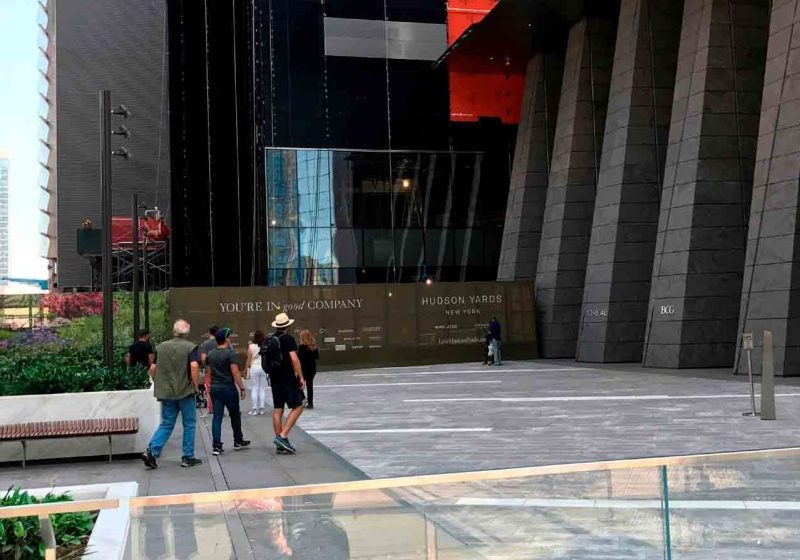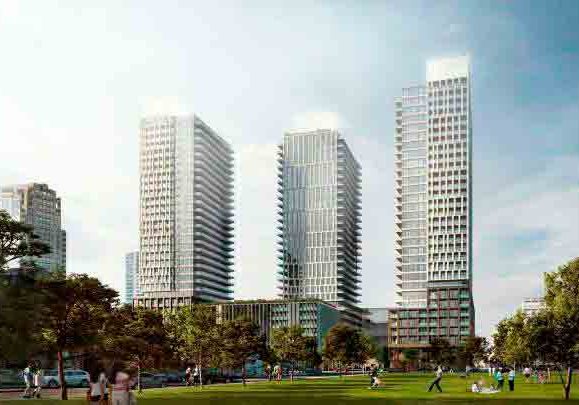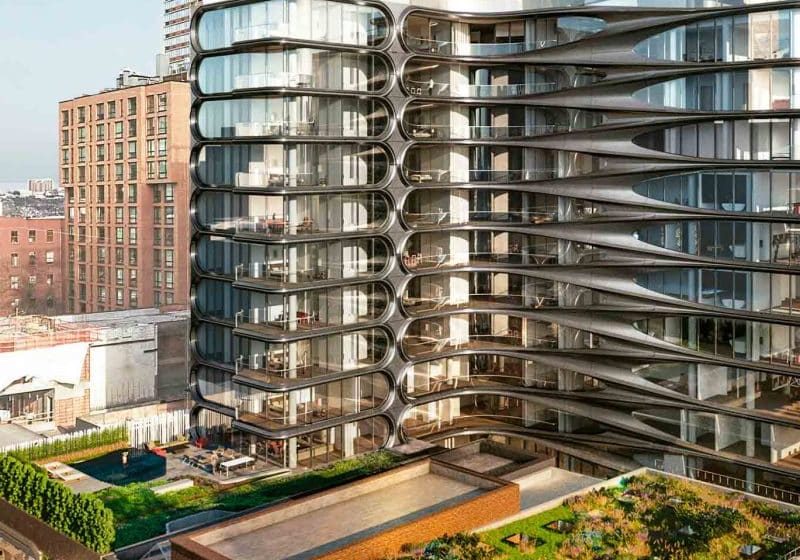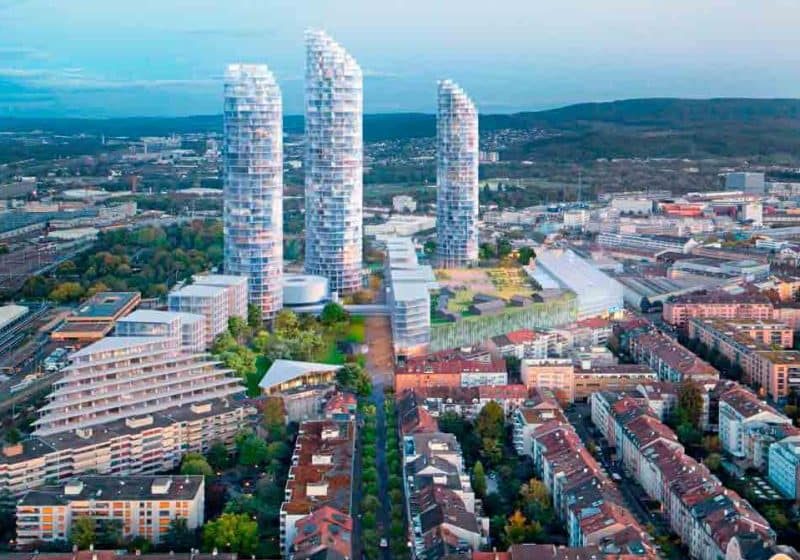The Year in NYC Tall Buildings
Mar 1, 2018

Neighborhoods transform as striking new landmarks punctuate skyline.
The Council on Tall Buildings and Urban Habitat (CTBUH), having recently completed its annual global audit of tall-building construction around the world, determined three buildings of 200 m or taller completed in 2017 in New York City (NYC), compared to four in 2016. In addition to those in the highest category, there were four buildings of 150-199-m tall, compared to five in 2016. CTBUH does not warrant the completeness of information for heights below 150 m, but in The Skyscraper Center database, CTBUH counts 13 additional buildings as having completed in 2017. Here, some highlights are examined.
200 m or Higher
50 West (237 m)
50 West (Street) is a 64-story, mixed-use high rise with retail and 191 residential condominiums. Architect Helmut Jahn designed the tower with a curved glass façade to provide panoramic views of NYC. An observatory with views of New York Harbor, Ellis Island and the Statue of Liberty is on the 64th floor.
3 Manhattan West (222.5 m)
3 Manhattan West is a 1.5-acre (0.4-ha) development being built on a platform over the rail tracks leading into Penn Station, just east of the larger Hudson Yards project. Its second-tallest building, a mixed-use structure at 435 West 31st Street, completed in 2017. See 5 Manhattan West, which also completed this year.
The Beekman Hotel & Residences (209.4 m)
This condominium tower abuts the historic Temple Court building, constructed in 1883 and notable for its elaborate central atrium. The Temple Court was converted to a 287-room hotel, while the adjoining tower holds 68 residences. The Beekman reflects the groundswell of interest over the last few years in turning Lower Manhattan from a business-only district into a more full-fledged, 24/7 neighborhood.
150-200 m
Tower 28 (197.2 m)
If NYC has been having a skyscraper boom, Long Island City (LIC) in Queens has been having its own sub-boom of late. Those approaching the neighborhood on the Number 7 train are increasingly finding their classic view of the Manhattan skyline obscured by new towers on the east side of the East River. Tower 28 was the tallest of this crop to complete in 2017. It is just a hair shorter than the Citigroup Building at One Court Square (205 m, 1990), which, until quite recently, was the only skyscraper in the area.
The Hub, Brooklyn (183.6 m)
Just a few years ago, the Brooklyn skyline was punctuated by just one significantly tall building — Williamsburg Savings Bank Tower (1927, 156 m), now called One Hanson Place. How things have changed! The Hub is one of the latest crops of tall, mostly residential towers appearing near the transit hubs of northwest Brooklyn, around Borough Hall, DeKalb Avenue and the Barclays Center/Pacific Park. Expect to see a lot more of this in coming years as Brooklyn becomes “the New Manhattan.”
American Copper Buildings: West Tower (164.7 m) and East Tower (143.1 m)
The American Copper Buildings, finalists for Best Tall Building Americas in the CTBUH 2018 Awards program, present two bold and dynamic residential towers on NYC’s East River. Clad in copper, this living material will patina gracefully over time, accentuating the tallest copper-clad building in the world. The 761-unit luxury rental community reaches 41 and 48 stories in height, with an iconic three-story skybridge connecting the two towers.
Twenty percent of these exciting, new apartments are affordable units. The development features an amenity package that sets a new benchmark for rental development, including the skybridge, indoor lap pool and lounge, rooftop deck, infinity pool, fitness center and spa. The towers, the bent forms of which appear to be dancing with each other, bring energy and inspiration for future innovative growth and resilient design in its neighborhood and along the East River. In addition to making an impressive addition to the skyline, the towers’ shapes create hundreds of unique layouts throughout the buildings.
100-150 m
1 West End Avenue (149.7 m)
The design for this building made the news in 2014 when it was criticized for having distinctly separate entrances for its mixed-income tenants. Dubbed the “poor door,” the arrangement was lambasted in the press as an example of the growing inequality in the city. The redesigned 1 West End still has separate entrances, but all residents will have access to such building amenities as a courtyard and river-view roof deck, and the affordable segment’s lobby is stylishly appointed and faces a park.
One Hudson Yards (119.8 m)
Part of the massive Hudson Yards project now underway on the West Side of Manhattan, this tower adds a residential component to balance a heavy investment in retail and office in the first phase. The second phase of Hudson Yards is planned to bring the finished total to 5,000 residential units.
DoubleTree by Hilton Hotel, New York Times Square West (104.3 m)
Another tall Hilton-affiliated property opened this year on the west side of bustling Times Square.
Less Than 100 m
215 Chrystie Street/The Public Hotel (95.7 m)
This much-anticipated Ian Schrager-branded hotel debuted in the Lower East Side near the Bowery, another area of massive change in NYC recently. Although the Bowery has almost completely shed its seedy reputation, the Public Hotel, while high end, contributed a bit of voyeuristic intrigue to the area. It seems that the floor-to-ceiling glass in the guest rooms tempted certain occupants to display their intimate activities in a very, well, public way.
5 Manhattan West (85.7 m)
A heavyset concrete ziggurat that once housed both the New York Daily News printing presses and stored furniture for retailer E.J. Korvette, 450 West 33rd Street, now 5 Manhattan West, has been completely reclad and renovated, retaining its distinctive shape while acquiring a glassy sheen. Its developer, Brookfield Office Properties, plans to lease to tenants in need of large floorplates.
Cornell Tech Residential (82.3 m)
This building is significant, both for its location and constitution. Part of the new Cornell Tech campus emerging on Roosevelt Island in the East River, the student residence is the tallest and largest building in the world to be designed to Passive House (Passivhaus) standards. Passive House (PH) is a strict international building standard that drastically reduces energy consumption, while creating a healthier and more comfortable living environment for a fraction of residents’ usual energy costs. With the level of insulation, glazing and air-pressure testing involved with PH, this new high rise is pioneering enhancement of building performance ahead of its time with upcoming NYC energy code updates.
The Dalton School (49.1 m)
Two stories were added to this prestigious Upper East Side institution, a building dating from 1929, as demand for elite education keeps pace with the boom in tall luxury residential towers.
520 West 28th Street (41.2 m)
One of the last buildings designed by the late Zaha Hadid to be completed in the U.S., its distinctive style added to the already-formidable collection of new developments along the High Line.
Get more of Elevator World. Sign up for our free e-newsletter.









